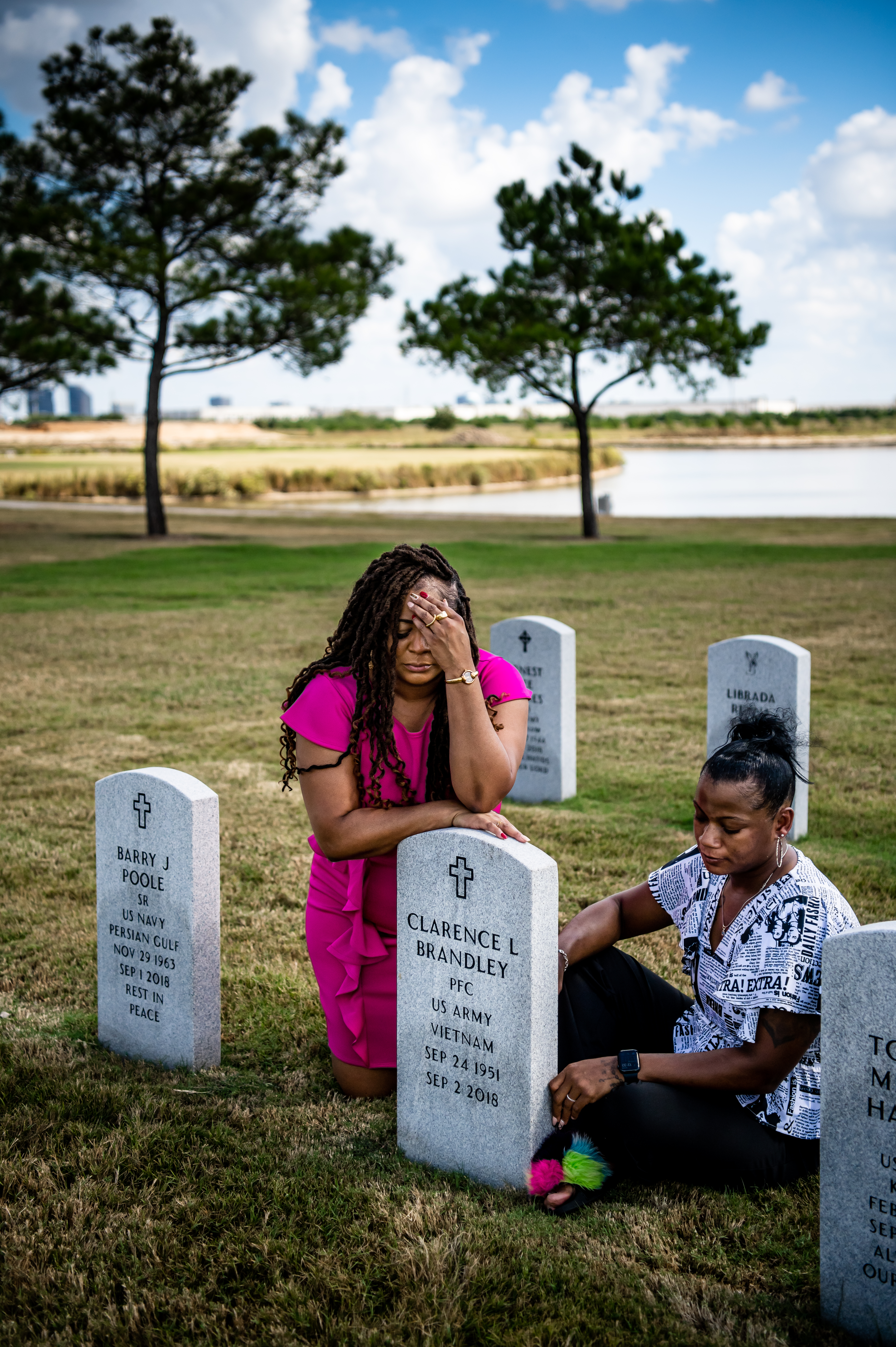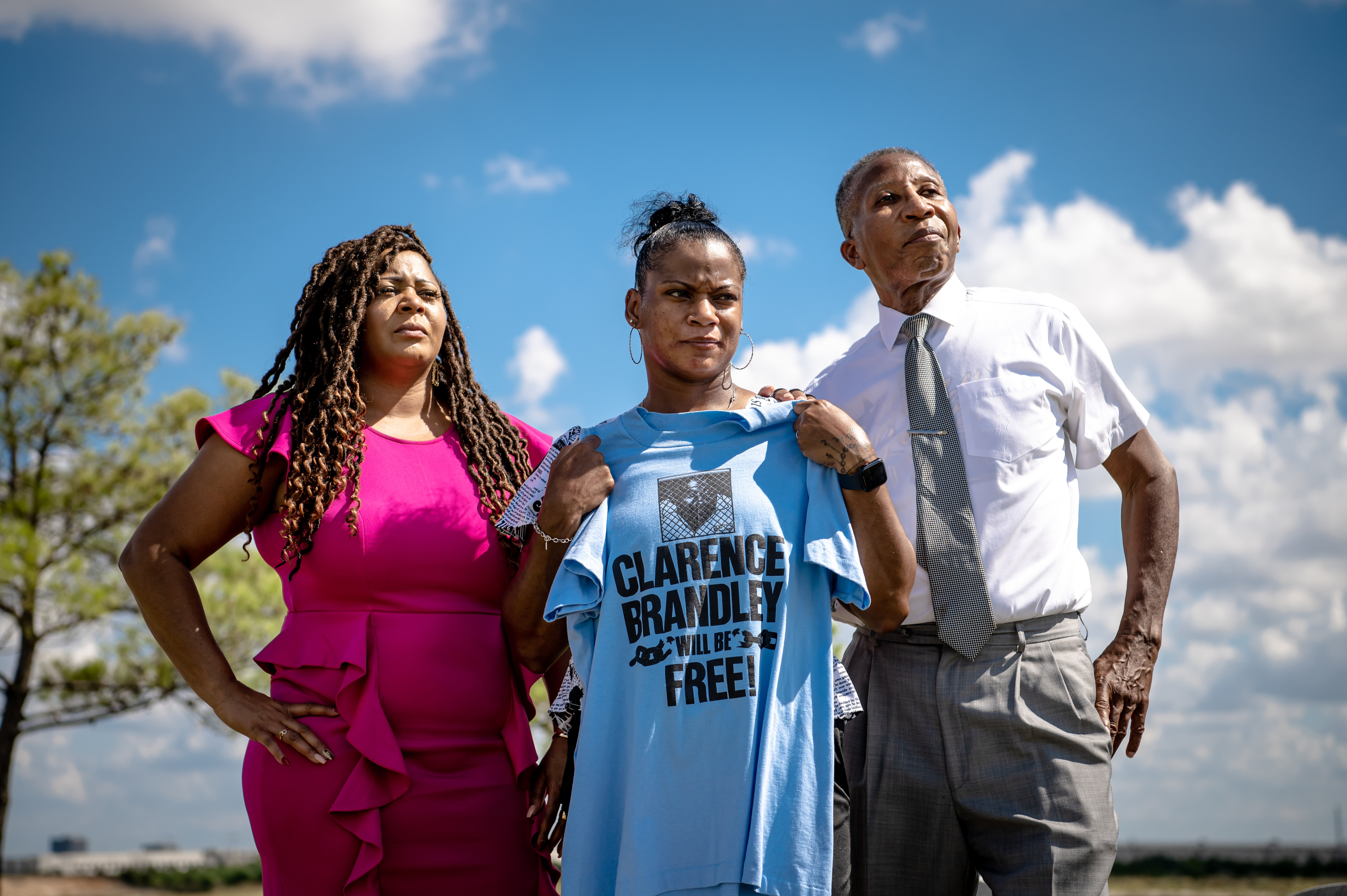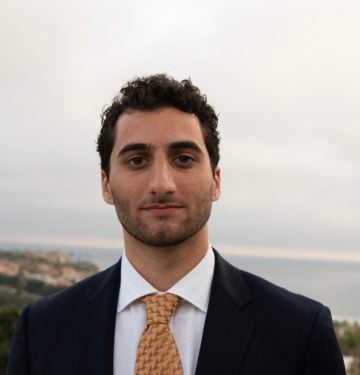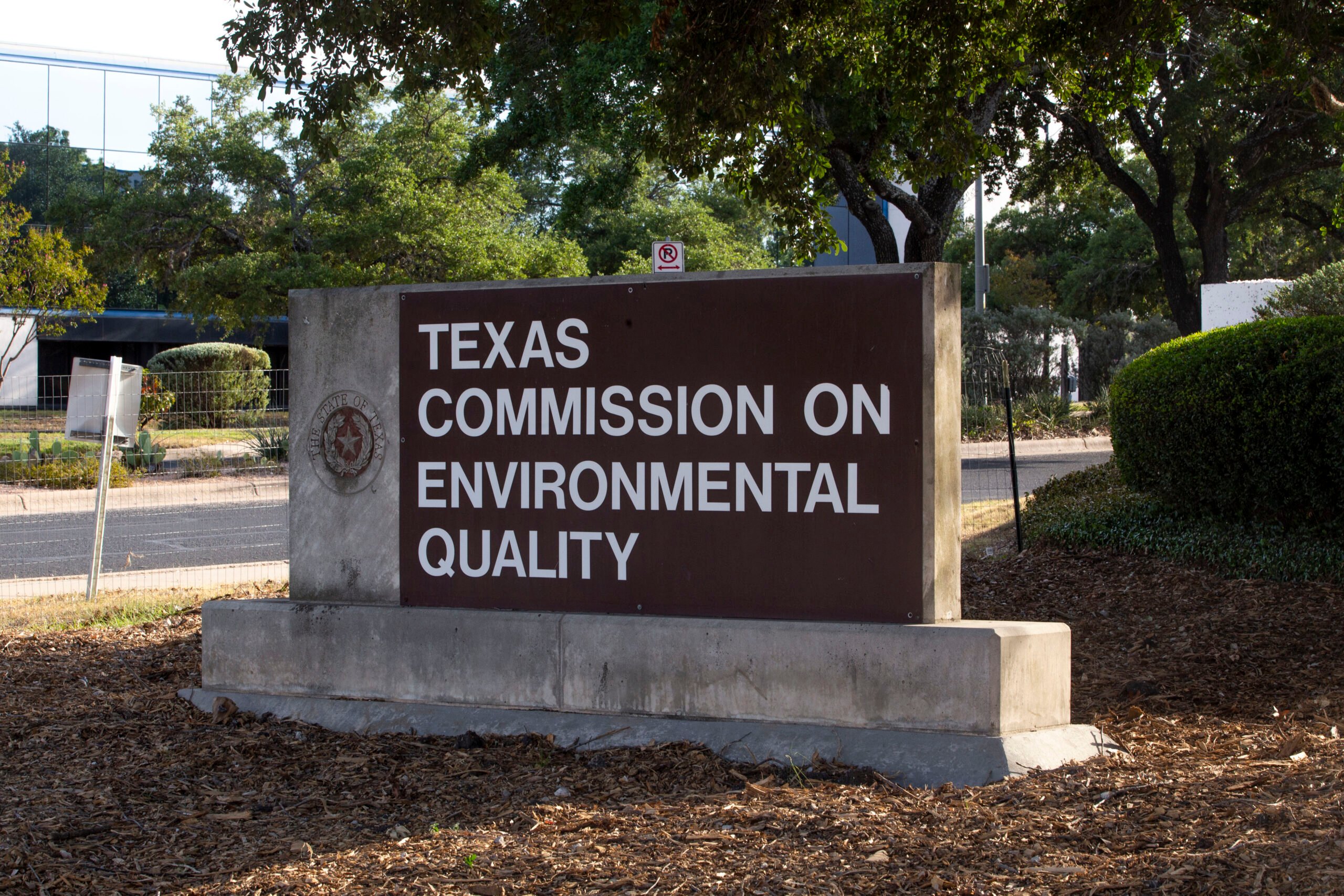On October 16, 2018, Ozell Brandley walked into the downtown Houston office of Mike DeGeurin, a lawyer who had helped exonerate his younger brother, Clarence Brandley. Clarence, who was wrongly convicted in 1981 of the rape and murder of 16-year-old Cheryl Fergeson, had spent nearly a decade on death row until new evidence helped free him in 1990. The only Black janitor on duty the day of the white student’s death in Conroe, the Montgomery County seat, Clarence had been railroaded; exculpatory evidence had been suppressed; and his wrongful conviction and death sentence had generated international publicity.
Gathered around a wooden conference table beside DeGeurin was another of Clarence’s former defense attorneys, Paul Nugent. Next to him were an investigator and a Texas legislator along with current Montgomery County District Attorney Brett Ligon and Clarence’s daughter, Cassie, sitting by her uncle Ozell.
Ozell, a pastor and substitute teacher, began with a prayer, then read a statement: “The late Clarence Lee Brandley and the late Cheryl Fergeson deserve more and better than what they have received from Montgomery County, Texas, and the State of Texas.”
While his brother Clarence had been released from prison and had his conviction set aside, his 32-year effort to secure restitution for himself and his five children had been in vain. Just six weeks after Clarence’s death, Ozell had taken up the cause.
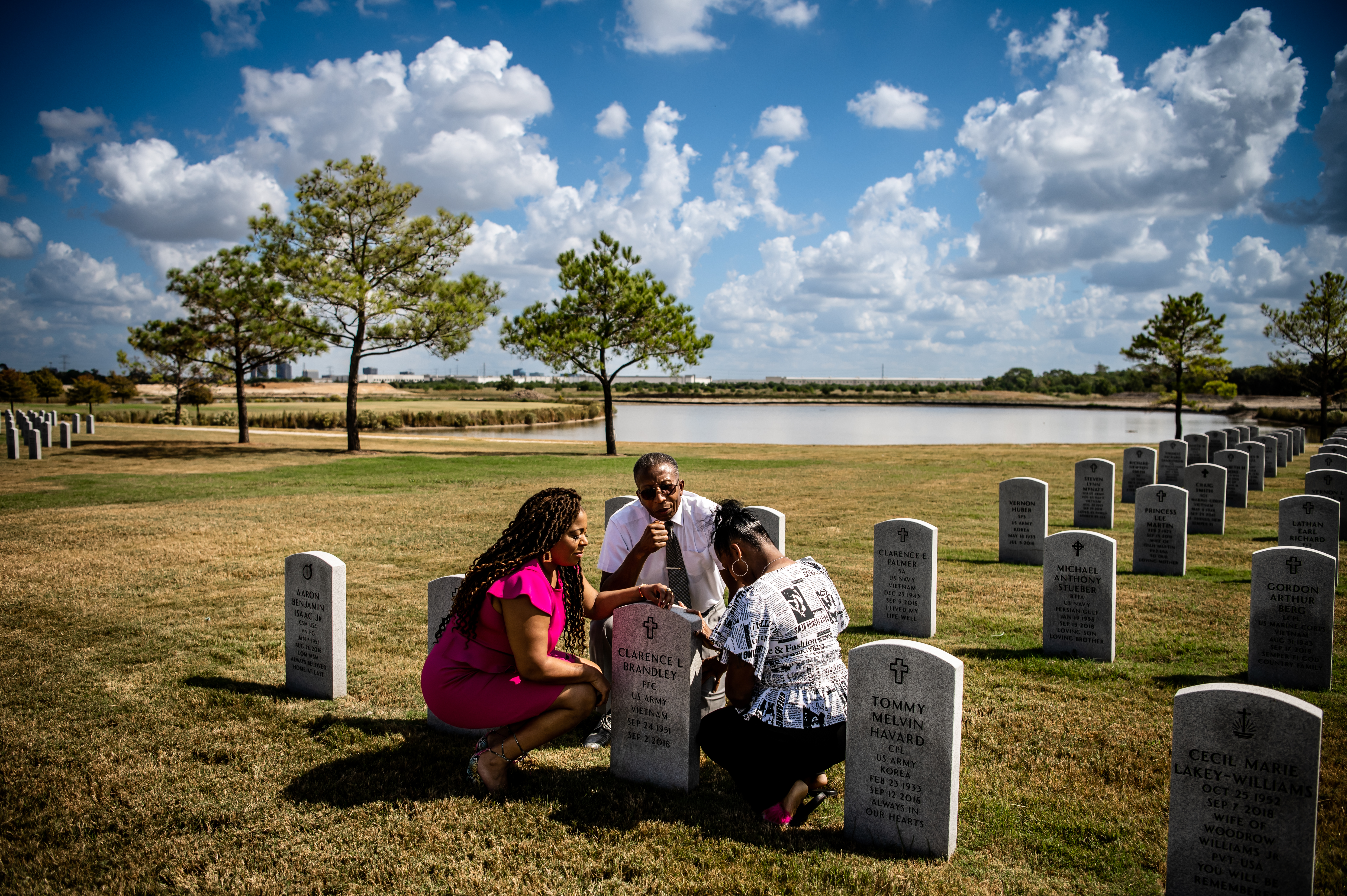
“Certainly, the children of my late brother are deserving of some compensation from Montgomery County, Texas, for all the suffering of their father,” he said. “They must have suffered also having to live without their father’s presence and encouragement.”
He kept his eyes trained on Ligon—whose support would be critical in securing a pardon from the governor, which would entitle Clarence’s family to compensation. When Ozell finished, Ligon declared he wanted to conduct his own investigation. He didn’t know much about the case: Ligon, a native of Montgomery County who became district attorney in 2009, had been in college in 1990.
Ozell insisted that any further investigation was unnecessary.
That’s when things became “heated,” Cassie, his niece, recalled. She watched when, about 30 minutes into the meeting, Ligon stormed out. DeGeurin went after him.
Upon his return, the meeting concluded with Ligon promising that his office would set aside $10,000 to hire a private investigator and would update the family in three to six months.
“At first, I did have some hope,” Cassie recently told the Texas Observer. “I really felt in my heart that they were investigating it.”
“At first, I did have some hope. I really felt in my heart that they were investigating it.”
But by the time Cassie spoke to the Observer, she realized the investigation “just went to the wayside.” The investigator DeGuerin and Ligon had agreed to hire four years before had not even begun looking into the case.
Despite follow-up calls, emails, and letters, nothing has been done. The pleas to provide just compensation for one of Texas’ most famous death row exonerees were being ignored again.
In 1991, a year after his release, Clarence Brandley sued more than 20 entities, including the district attorney, the judge who presided over the trial in which he was found guilty, the State of Texas, and the City of Conroe. The U.S. Fifth Circuit Court of Appeals ruled that those officials and entities had immunity.
In 2011, he learned he could file for compensation under Texas laws protecting the wrongfully convicted after new legislation passed. With his brother Ozell’s help, Clarence submitted an application to the comptroller. It was denied.
In the eyes of the state, Brandley was ineligible because he had not been declared “not guilty” of a crime; in order to win compensation, exonerees must provide proof—either a court finding or a pardon from the governor—attesting that they are innocent. Brandley’s previous conviction had merely been thrown out.
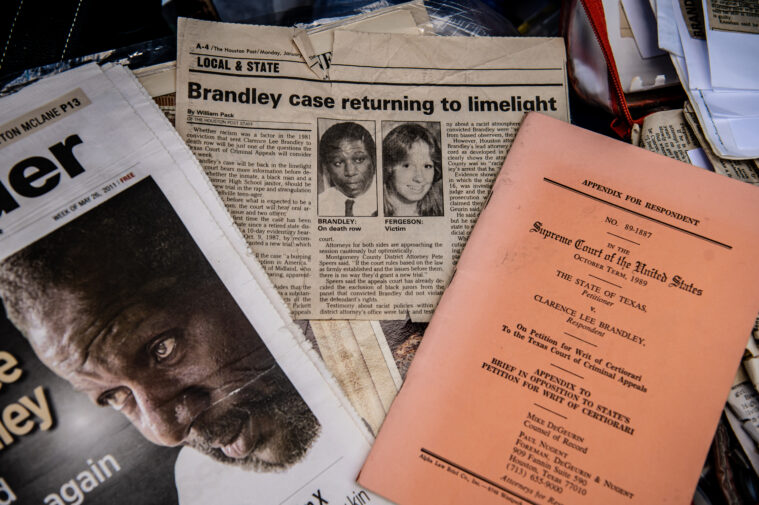
Clarence, his five kids, and Ozell spent the next seven years lobbying legislators for reforms to make him (and others) eligible, holding press conferences and public events to raise awareness, and coordinating with former defense lawyers and the district attorney in the hope of righting the wrongs of four decades of injustice. Laws passed, but still Brandley never qualified.
Then on September 2, 2018, Clarence died of pneumonia and other complications at the age of 66. In his honor and memory, his family continues a fight that began way back in 1980.
During a volleyball tournament at Conroe High School on August 23, 1980, Cheryl Fergeson walked down an empty hallway between the auditorium and the cafeteria and up a set of stairs to the girls’ restroom.
At the foot of the stairs, three janitors—John Sessum, Sam Martinez, and Gary Acreman—waited to hear about their next assignment from their boss, 28-year-old supervisor Clarence Brandley.
Brandley came by, toilet paper in hand, and told the three men to set up chairs in the vocational building across the street. He stayed behind to restock the restrooms.
Another janitor, Henry “Ickie” Peace, joined the trio as they walked over, but the door was locked. Brandley arrived 45 minutes later with a towel around his neck, then handed them the keys before returning to the main building. Two hours later, Brandley and Peace walked back to lock up the cafeteria.
There in the hallway, Brandley and Peace encountered Fergeson’s friends searching for her. Brandley and Peace helped by checking for unlocked doors. They happened upon the auditorium door, which was open. Inside, behind a sheet of plywood in a prop loft, Brandley and Peace discovered Fergeson’s lifeless, naked body.
The day of the crime, a white Conroe police officer interviewed Brandley and Peace. During questioning, according to Brandley, the officer looked at the two janitors and said, “One of you two is going to hang for this.” Pointing at Brandley—the only Black man on the janitorial staff—he said, “Since you’re the nigger, you’re elected.”
With the first day of the new school year just over a week away, police were under intense public pressure to find the murderer. Five days later, Texas Ranger Wesley Styles kicked off the investigation. Less than 24 hours into the job, before interviewing any witnesses, Styles arrested Brandley, who was on probation for a misdemeanor weapons charge.
August 29, 1980, was Brandley’s last day of freedom for more than 10 years.
“They walked me across the street where all the media was taking pictures. It was almost like it was a show,” he recalled years later.
The following day, three of the four janitors—Sessum, Martinez, and Acreman—walked Styles through their recollection of events at the high school. They said that Brandley appeared shortly after Fergeson went to the bathroom, sent them to the vocational building, and was unaccounted for during the next 45 minutes. Prosecutors would argue Brandley committed the crime during this timeframe, using the towel to strangle Fergeson.
During jury selection, the office of Montgomery County District Attorney James Keeshan successfully sought to exclude Black jurors from the jury pool. At the time, controversial and even illegal practices for striking jurists of color were advocated in prosecution manuals and routinely used in Montgomery County. “All black persons were to be stricken from the jury panel when there was a black defendant,” court records later showed, and departing from “standard practice” required an explanation.
At the first trial in December 1980, Peace, who found the body with Brandley, served as the state’s key witness. He testified that Brandley repeatedly suggested searching the loft where Fergeson’s body was found—demonstrating, prosecutors argued, that Brandley knew where the body was. Beside the testimony of Brandley’s colleagues, prosecutors relied heavily on a pubic hair found near the victim’s vagina, which a state crime lab said came from a Black male. Using hair comparison techniques later deemed junk science, the lab concluded those hairs “appear identical to pubic hairs removed from said Brandley’s person.”
When he took the stand in the first trial, Brandley was like “a doe in the headlights,” his first defense attorney said. He rambled. Brandley also had no alibi: He said he was alone in his office, smoking a cigarette.
The first trial ended in a mistrial, with a lone juror refusing to support a conviction.
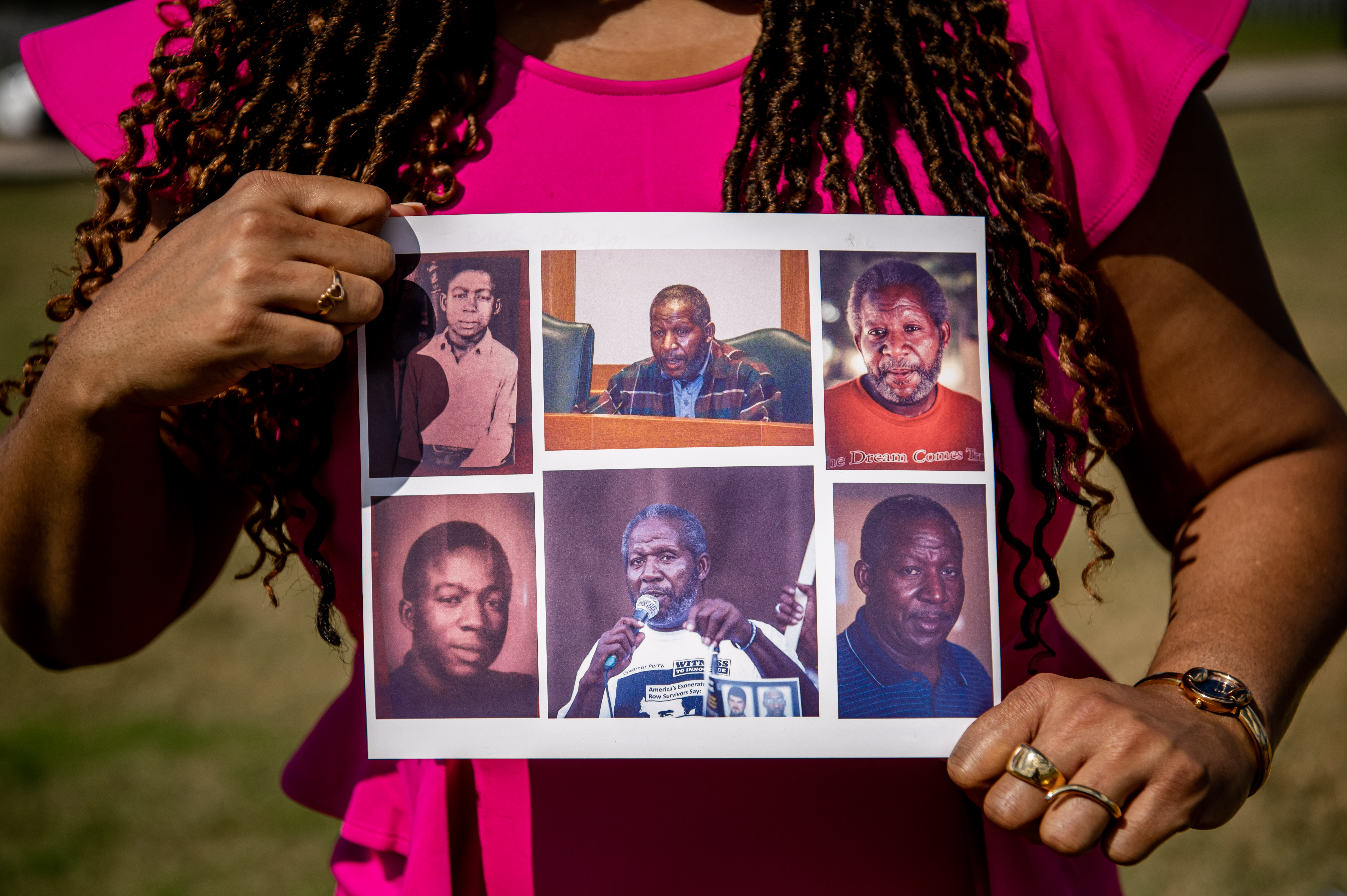
After the first trial, Peace admitted in an interview that he had perjured himself and falsely implicated Brandley. He had done so under pressure from investigators, who he said told him, “You’re a suspect in a murder case, and you’re going to tell us what we want to know.”
There was no fallout from that revelation. District Attorney Keeshan pushed forward, and a second trial took place six weeks later. On February 13, 1981, Brandley was convicted of capital murder by another all-white jury entirely on circumstantial evidence and the testimony of the four white janitors.
He was sentenced to death by lethal injection, “before the hour of sunrise,” on January 16, 1986.
Brandley was sent to death row, then at the Ellis Unit just north of Huntsville.
“Death row is not a picnic. When I first got there, it was killing and stabbing every week,” Clarence told the Houston Chronicle in 2015. “The more brutal the prison guards were to the inmates, the more rank they would make. In the wintertime, they would open up the windows. In the summertime, they would close up the windows. And so it was just a living hell.”
The worst part, for him, was that his kids were young—Clarence Jr. was 8; Cassie, 5; Eric, 3; and Elizabeth, 2—when he was taken away, robbing him and them of moments that can never be recovered.
“Because he spent most of his life in prison while his kids were growing up, he wasn’t able to see us if we were in sports or anything or any type of activities, come to our awards program,” Cassie told the Observer. “It was just a lot for him not to be a part of that and for the state to take him away from us.”
“I’ve been mad since I was a kid,” Eric added. “Our father could have taught us how to fish, you feel?”
“I’ve been mad since I was a kid. Our father could have taught us how to fish, you feel?”
Eric failed two grades in elementary school, “but it wasn’t that I was stupid. We were having hard times.”
Clarence Jr. got roughed up at school. “You’re a rapist’s son. You’re a rapist’s son,” classmates shouted at him.
“I’m a junior. I had his name. I had it hard,” Clarence Jr. said.
Cassie recalled that a science teacher saw her name and said in front of her classmates, “I wonder if she’s kin to that son of a gun who raped a white girl.”
Ozell would drive the kids to see their father in Huntsville during the summer. Clarence would ask them how they were doing in school. The children were grateful to visit their father in prison. “They were still small, but they understood what being locked up meant,” Ozell recalls.
Throughout Clarence’s detention, Ozell worked with Houston civil rights leaders Jew Don Boney and Deloyd T. Parker Jr. to bring attention to the case. They organized demonstrations and put on plays at the Montgomery County courthouse and at the S.H.A.P.E. Community Center in Houston’s Third Ward to dramatize Clarence’s plight. It took this steady stream of activism, help from new defense attorneys and investigators, and more time for the next breakthroughs to happen.
Five years into Brandley’s incarceration, defense attorneys unearthed new information that cast more doubt on his conviction and won a stay of execution. In an evidentiary hearing held July 17, 1986, Brenda Medina shared a story about her common-law husband, James Dexter Robinson, a former janitor at Conroe High School. Medina said that Robinson—who was never questioned by police—came home on the day of the murder, told her he had “killed a girl” and needed to skip town. By morning, Robinson had gone, leaving behind shoes covered in blood.
An investigator tracked down Robinson in South Carolina and convinced him to return to Conroe for questioning. Hooked up to a polygraph, Robinson was asked whether he had killed Fergeson.
He paused for four and a half minutes before answering. “I could have done it and forgot,” he said. Then, he backtracked: “No, I couldn’t have done it. I’m not that kind of person. I’m innocent.”
None of it seemed to matter. On December 22, 1986, the Texas Court of Criminal Appeals denied Brandley’s request for a new trial. A new execution date was set for March 26, 1987.
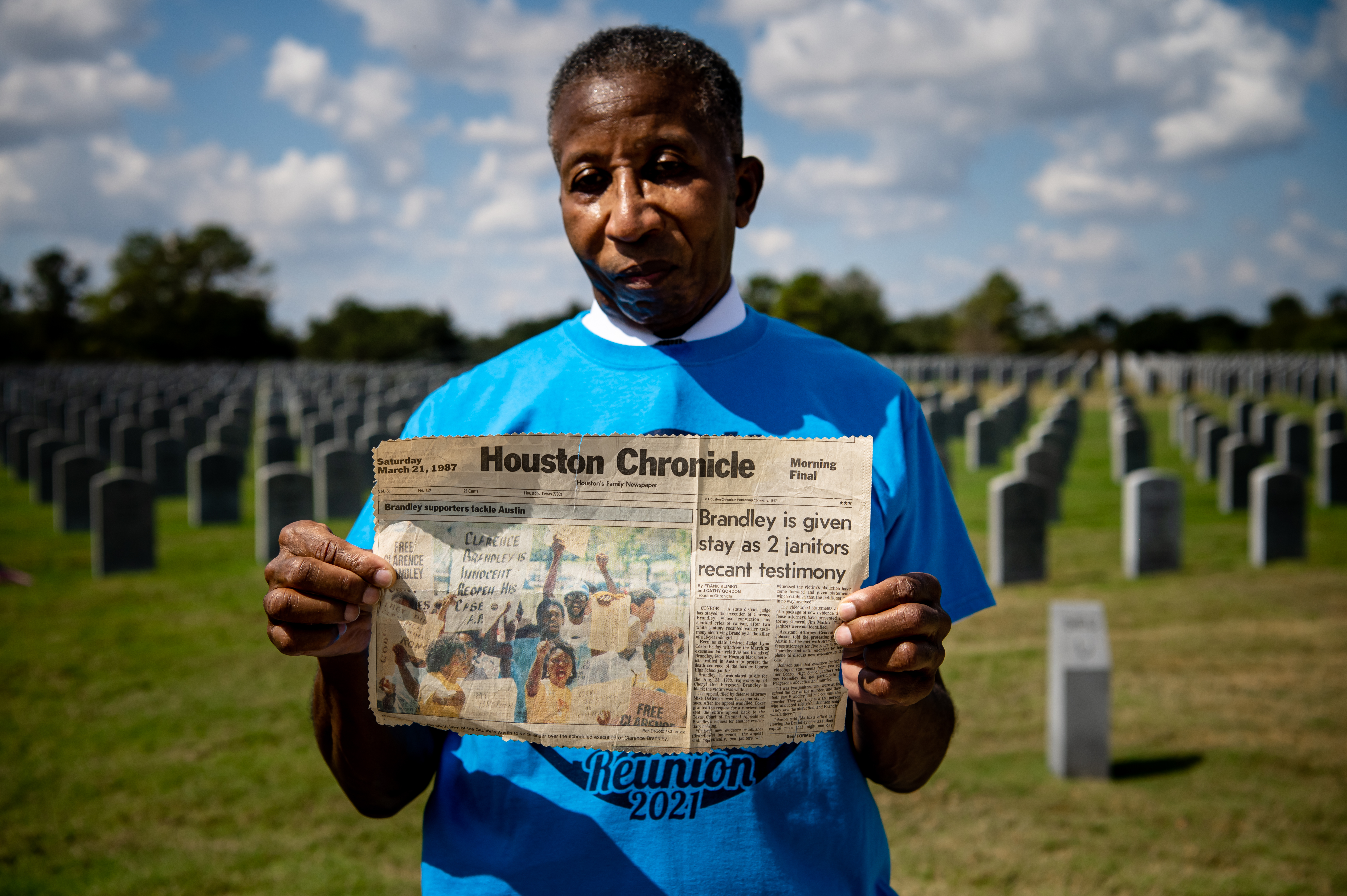
Nine days before Brandley was set to be put to death, the defense team met with janitor Gary Acreman, who had reached out wanting to talk. Acreman said that he had seen Robinson follow Fergeson and drag her into the bathroom. He said he later saw Robinson place Fergeson’s clothes in a dumpster.
“I don’t think Clarence Brandley was guilty of it,” Acreman said. “Well, I know for a fact that he wasn’t.”
With a videotape of Acreman’s remarks, the defense asked the attorney general to stay the execution. On June 30, 1987, the Court of Criminal Appeals granted another evidentiary hearing.
Outside Conroe this time, in Galveston, all four janitors changed their tune, according to court records. Sessum admitted that he had also committed perjury at Brandley’s first trial. In new testimony, he implicated both Robinson and Acreman, telling the courtroom that Acreman said Fergeson was “good looking” before he and Robinson followed her. Acreman talked to her at the top of the stairs, then grabbed her, according to Sessum. Sessum heard Fergeson’s final calls before she was raped and killed: “No, no.” “Don’t!” “Help.”
Sessum said that lead investigator Ranger Styles had threatened him with arrest if he didn’t cooperate. Acreman also told Sessum not to tell anyone that Acreman had talked with Fergeson outside the restroom.
Peace alleged still more official misconduct. In sworn testimony, he said Styles appeared at his house after dark on the night of the murder and drove him 23 miles east to a police station in Cleveland, Texas. Along the way, Styles allegedly “threatened to blow Peace’s brains out,” according to court documents. At the station, Styles roughed him up, keeping him until he signed a statement police had written that implicated Brandley, Peace said. Peace, who could not read or write, said he asked if someone could read the statement to him, but police refused.
“I have no idea what was on my statement,” he said at the evidentiary hearing.
Robinson testified that he had indeed told his wife that he had killed a girl but claimed he was living in South Carolina at the time. Five witnesses, including Acreman, Sessum, and Medina, testified that they saw him in Conroe before the murder.
Senior Judge of the 142nd District Court Perry Pickett wrote that Brandley had not received a fair trial and “did not commit the crime for which he now resides on death row.”
“In the 30 years this Court has presided over matters in the judicial system, no case has presented a more shocking scenario of the effects of racial prejudice, perjured testimony, witness intimidation, an investigation, the outcome of which was predetermined, and public officials who, for whatever motives, lost sight of what is right and just,” Pickett said from the bench.
“In the 30 years this Court has presided over matters in the judicial system, no case has presented a more shocking scenario of the effects of racial prejudice, perjured testimony, witness intimidation.”
Pickett recommended a third trial for Brandley away from Conroe. On December 13, 1989, the Court of Criminal Appeals ordered his release from death row.
On January 23, 1990, Brandley was finally free, only the second person ever released from Texas death row, according to the National Registry of Exonerations.
As Brandley walked out, prisoners were cheering, and even some guards.
“It’s a great feeling just walking outside of the gate and knowing that now I’m standing on some grass. There’s no concrete and I’m not in handcuffs,” Brandley told reporters. “Now I feel like it’s just a matter of time now to be able to go and do what I wanted.”
After prison, Clarence Brandley became an ordained Baptist minister, preaching in a former auto parts warehouse-turned-church called God’s House. He trained briefly to be an electrician and worked as a tow truck driver for the Metropolitan Transit Authority in Houston.
“You just do what you want because you don’t have nobody telling you what time you’ve got to be back and all of that,” Clarence told the Houston Chronicle in 2010. “Your life is not controlled anymore.”
But Clarence wasn’t the same after his return.
“I think he would try to be there but couldn’t be there mentally, fully,” Elizabeth said. Just 2 years old when her father was convicted, Elizabeth felt she truly met him for the first time at a Sunday service at Creston Baptist Church days after his release from prison. She was 11.
Her mom introduced them. Clarence gave her a brief hug. They talked a little. She invited him to come to her sixth grade graduation; he came, and they took a picture.
But the new relationship was complicated. Elizabeth had grown up believing her father was someone else. The man who had raised Elizabeth nearly all her 11-year-old life was Michael Wayne Norris. She discovered that Norris wasn’t her father after he was convicted of capital murder for killing an ex-girlfriend and her 2-year-old son in 1987 and sentenced to death row. That’s when she learned that her real father, Clarence Brandley, had been sentenced to death too. It was years later in her 20s, after counseling, that Elizabeth decided she “needed to try to develop a relationship with my father.”
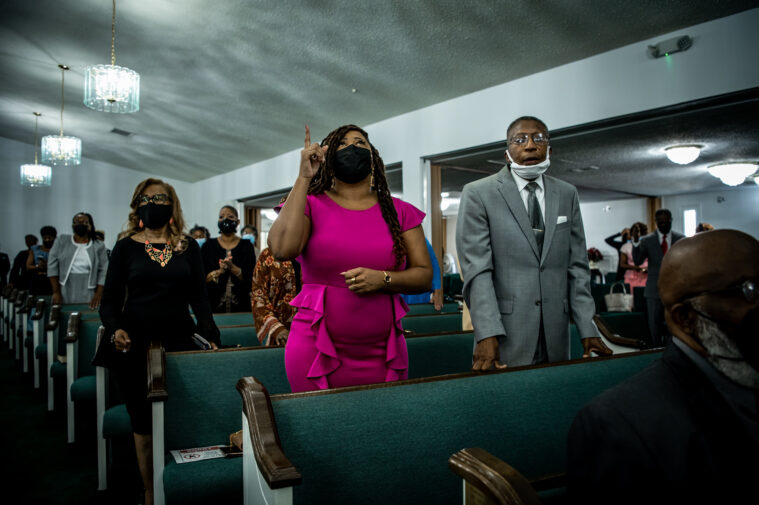
“Whatever happened, I had to forgive him about it,” she said. Elizabeth would visit her father regularly, bringing her five children to see their grandfather. They spent holidays together. “And before he passed away, we had a relationship.”
Clarence himself was never able to truly escape what Judge Pickett had originally described in his ruling from the bench as “the pervasive shadow of darkness.” He had lived for nearly 10 years on death row, in the darkest part of that shadow of racism and hate. And even as a free man, he lingered in a penumbra of psychological torment, uncertainty, and injustice, never able to completely bask in the light.
“His mind was just gone,” Cassie said.
Clarence struggled—losing his job, car, and house in the 2008 recession. But he kept fighting for justice. He wanted compensation, he told the Houston Chronicle in 2011, because “it would get me something so I could start all over again.”
“I want to open up a little barbecue pit,” Clarence said.
At the time of Brandley’s release in 1990, Texas law supposedly allowed “persons wrongfully imprisoned” to be awarded up to $25,000 for pain and suffering in addition to $25,000 for medical expenses.
From 1985 to 2001, only two exonerees had been successful in doing so. The law was so little-known that Brandley would only find out about the option decades later.
Texas overhauled its laws on compensation for wrongful convictions in 2001, when state Senator Rodney Ellis pushed through a bill that raised the compensation amount from a $25,000 flat fee to $25,000 for every year served in prison. Compensation was capped at $500,000.
To win support from the Republican-dominated Legislature, two provisions were tacked onto the bill. The first ensured that those who sought compensation from the state could not also sue, which forced claimants to decide which of the two avenues to pursue.
The second concerned how far back the law would apply. Brandley was a discussion point in those negotiations, but the final bill excluded him.
“I was trying to work it in to get Clarence,” Ellis recalled. “I just remember somebody saying, ‘Nice try.’”
In May 2009, the Timothy Cole Act increased the lump sum to $80,000 per year plus an annuity. It also allowed exonerees to participate in a state insurance plan and receive four years of state-paid secondary education. The bill’s namesake, Tim Cole, had served more than half of a 25-year sentence for a rape he did not commit before dying in prison. Cole was posthumously exonerated and pardoned.

It was in 2011, after the Tim Cole Act passed, that Brandley sought compensation through the state. The Texas Comptroller’s Office rejected the claim, finding that Brandley was past the deadline. He needed to have applied by December 13, 1992, in accordance with the three-year time limit imposed by the 2001 reforms.
Furthermore, the comptroller said Clarence Brandley did not qualify because he had not been declared “actually innocent” either by a court proceeding or by a governor’s pardon—a requirement established in 1994 by a Texas Court of Criminal Appeals decision.
Brandley was being judged by standards that didn’t exist when his case was thrown out in 1989 or when he was released in 1990.
Days after receiving the letter, Clarence Brandley and his brother Ozell organized a press conference.
At the S.H.A.P.E. Center, representatives of civil rights and community organizations such as Witness to Innocence, the National Black United Front, and the Texas Death Penalty Abolition Movement denounced the state’s decision.
“Silence reigns with no remedy,” Ozell said. “[The decision] has only echoed [that] there is no justice for those wrongfully convicted, incarcerated, and sentenced to death. No justice in the courtroom. No justice in compensation for those whose lives and families have been devastated and suffered unmerciful humiliation and shame.”
“No justice in the courtroom. No justice in compensation for those whose lives and families have been devastated.”
Clarence spoke, too. “I don’t want to take long today because I think my brother has already preached his sermon today,” he said. “But I’m prayerful and thankful that eventually, I think, things is going to work out. It’s just a matter of time.”
The same day, the Texas Legislature passed a law requiring that all recently exonerated individuals be provided with written and oral guidance on how to obtain compensation and contact information for nonprofit advocacy groups that could assist them.
The brothers stuck together as the journey veered into politics, lobbying lawmakers like Ellis for a legislative solution that would make Clarence eligible for compensation. The pair attended the first “Day of Innocence” at the Texas Capitol put on by Representative Harold Dutton to recognize exonerees. Clarence also spoke at events like the 2012 Texas Democratic Party State Convention and at the Thurgood Marshall School of Law at Texas Southern University.
Ozell wrote a book in 2018 about the failures and workings of the American criminal justice system, including anecdotes about his brother’s legal battle and his ongoing fight for compensation. The book, Passing the Bucket for Justice, included the story of how Conroe citizens collected almost $8,000 for Clarence’s legal fees by going door to door in their neighborhood with buckets.
Those efforts did not end even with Clarence’s death in September 2018.
Ozell Brandley knows that the only remaining avenue to secure compensation on his brother’s behalf is to obtain a declaration of actual innocence—a court ruling that would extend the family’s deadline to seek compensation.
But trying to convince the courts to declare a dead man innocent is “highly doubtful,” according to Mike Ware, executive director of the Innocence Project of Texas. Essentially, one would have to ask a judge for the old dismissal to be withdrawn and for a new one to be entered.
Another approach would be to seek a posthumous pardon from the governor. Ozell wrote Governor Greg Abbott a letter asking for support in November 2019 and was told he’d be contacted later but never heard anything more.
The family still sees Montgomery County DA Brett Ligon as the linchpin to their efforts. He could assist them in trying to secure a declaration of innocence.
“If the DA was really petitioning the governor, the Board of Pardons and Paroles, it would go a long way toward getting the pardon for innocence,” said Brandon Dudley, long-time chief of staff to Ellis, now a Harris County commissioner.
But little progress has been made since that 2018 meeting. The Montgomery County District Attorney’s Office declined to make Ligon available for an interview.
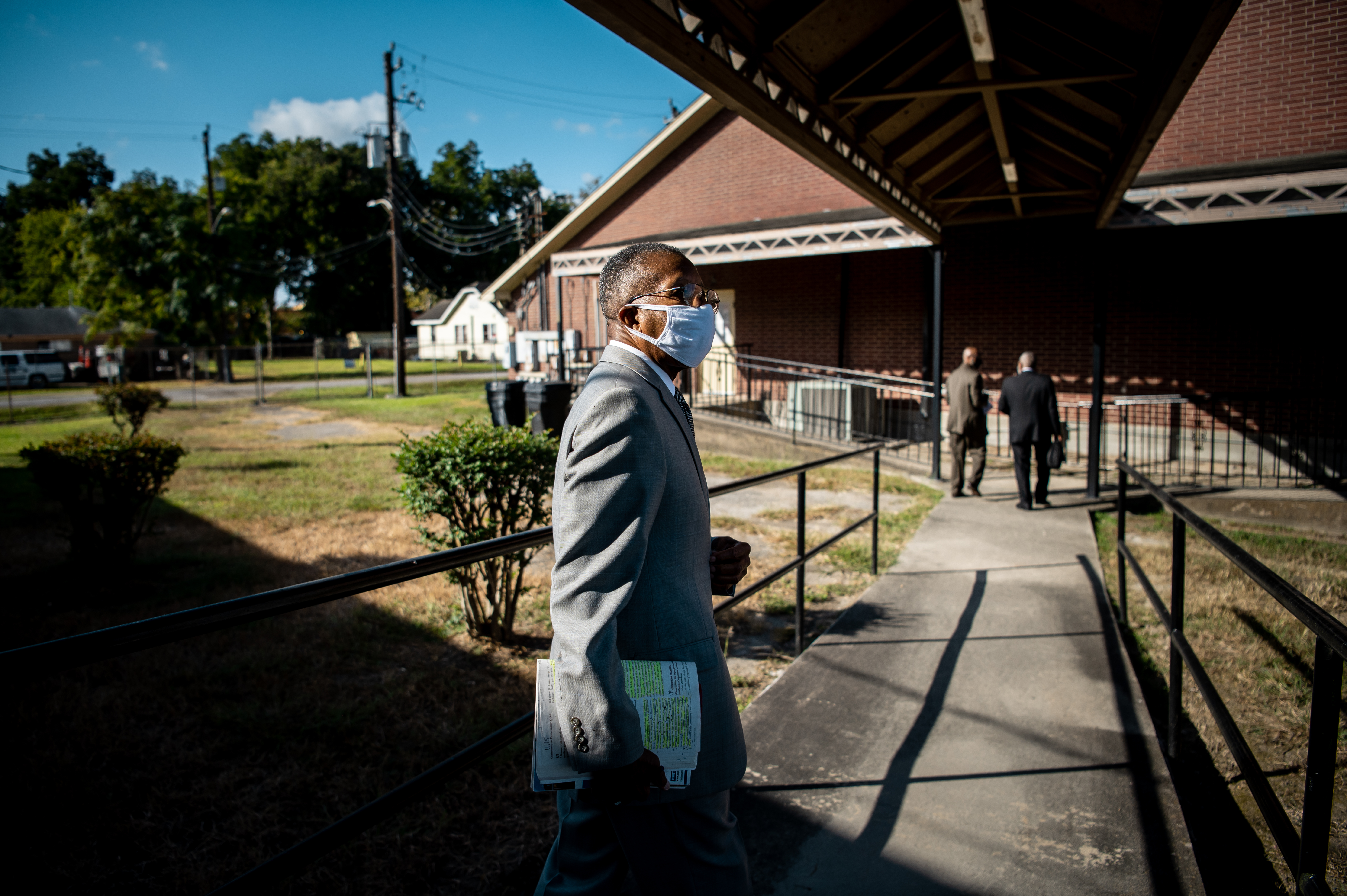
“Mr. Ligon has offered to fund a private investigator of Mr. DeGeurin and the family’s choice to investigate questions raised by Mr. Brandley’s prosecution,” the DA’s office wrote in a September 8 email. “An investigator was identified, but we are unaware of any developments from this investigation.”
“He didn’t do nothing,” Ozell remarked after I read him the email.
Defense attorney Mike DeGuerin selected attorney and private investigator Brian Benken to run the investigation four years ago. But Benken “has been difficult to reach” and “did not seem interested when I spoke with him,” DeGeurin said. (Benken did not respond to multiple requests for comment.)
DeGeurin admitted “we chose the wrong investigator” and said it was “embarrassing” that nothing had been done for four years. “I have to blame myself,” he said. DeGeurin, Clarence’s champion, who had worked with other members of the defense team to save an innocent man’s life, had let things slip.
But DeGeurin plans to work with Ligon to identify a new investigator, “somebody with a heart in the case.”
“I’m optimistic,” DeGuerin said.
For the family, it’s been a 43-year fight, enough time to beat down even the strongest of wills. Eric feels exhausted and hopeless. “They ain’t gonna do nothing. They haven’t done it all this time. We’re in our 40s and 50s. We ain’t no kids no more. We grown men,” he said. “I still don’t believe no justice goin’ to be served. I still don’t believe it.”
“It’s just a bunch of running around,” Elizabeth said.
In Conroe, studded black letters on the red brick facade of the county administration building memorialize the former district attorney who put an innocent man away, later became a judge, and for decades still maintained he got it right. The state never returned to examine other suspects in Fergeson’s death. Everyone walked away scot-free—except for Clarence and his family.
“Truth will last,” Ozell said to me one day after yet another impassioned plea on his brother’s behalf.
Justice, though, is another matter.
